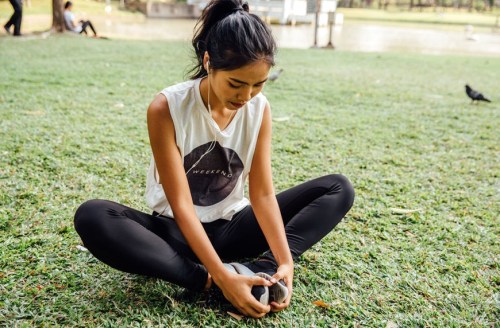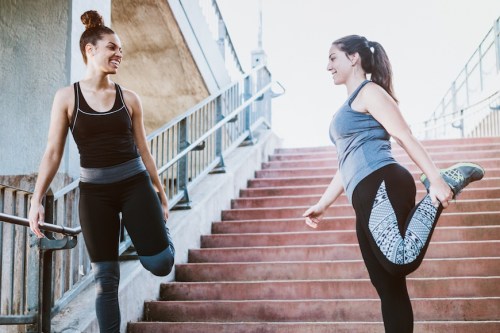If I took a quick poll about everyone’s least favorite part about working out, I’m pretty confident that stretching would end up somewhere on the list. Seriously, when the instructor tells the class it’s time to cool down it feels like a mass exodus. #Wheresthelife
“I think for many, it comes down to boredom,” explains Ife Obi, certified pilates instructor and owner of The Fit In Bedstuy. “The stretch is never as fun as the workout. It’s slow, it’s sometimes painful, and the importance of flexibility is not understood by the masses, which all this leaves little motivation to fit it in.”
However, the importance of post-workout recovery shouldn’t be overlooked. According to Jeff Brannigan, program director of Stretch*d, stretching “is the behind-the-scenes powerhouse that will help you perform better, recover faster and age gracefully.” He says that the a bulk of his clients often complain about tightness in the hips, low back, neck, and shoulders. So, to combat that, here’s how to minimize soreness post workout.

Here’s how to beat post-workout soreness
1. Stretching because…duh: “Stretching is usually an afterthought for most people. And, if you look at our lifestyles, this is understandable—lots of sitting at desks, hunching over laptops and staring down at phones will contribute to these areas of pain,” he explains. “We see lots of clients who are sore from their regular workouts but almost as many who are simply tight or stiff from a sedentary lifestyle. Text neck is real!”
To avoid excess soreness in the first place, physical therapist, Karena Wu, DPT of ActiveCare Physical Therapy recommends dynamic stretches to warm up the muscles before starting an activity. “Cardiovascular exercises typically don’t make you as sore as weight lifting since it’s a repetitive motion but not against a lot of load. Taking the time to warm up and cool down will help you avoid or minimize soreness. Static stretches are best after working out to lengthen the muscle fibers and minimize any lactic acid build up in the muscles.”
She recommends the figure four stretch for the glutes, side lying heel to buttock for the quads, lying on a foam roller with it parallel to your spine and stretching the arms straight out to the side for the pecs and biceps. “Take the time to stretch after working out to maintain muscle length and assist fluid circulation to reduce lactic acid buildup,” she adds.
2. Keep hydrated…and bath-adjacent: According to owner/founder of Erika Bloom Pilates, celebrity trainer and wellness expert, Erika Bloom, staying hydrated is key to minimizing soreness. Drinking plenty of water can help flush out toxins from your body and prevent dehydration, which can make muscle soreness even more painful.
Speaking of water, she also recommends a warm soak in a tub with epsom salt or magnesium, accompanying along with gentle self-massage with arnica oil to help assist with recovery. However, there’s also evidence that taking it in the other direction temperature-wise can help. Obi is a fan of cryotherapy—especially since cold can help relieve the tiny tears in the muscles that cause soreness. “You can hit a cryotherapy center, find a spa with a cold plunge, or draw up your own ice bath,” she explains.
3. Opt for lower impact fitness “Pilates is ideal for avoiding soreness,” Bloom explains. “It focuses on working the muscles both eccentrically and concentrically to stretch as you strengthen. It also teaches the small and large, intrinsic and extrinsic muscles of the body to work together around an aligned skeleton so that joints stay aligned and you can access all the fibers of each muscle without strain.”
While many of us are used to feeling sore after a killer workout, occasionally it can be something more serious—like a strain or sprain. “If [the pain] lasts longer than two days, you probably pulled something,” explains founder of AQUA Esther Gauthier. “The key to safe stretching is good form and progressively working through the stretch while breathing with intention.”
Those looking for a recovery workout to minimize soreness can opt for water-based option, like aqua cycling. “The salt water flushes lactic acid out of your muscles while working out which reduces the soreness. You get an effective workout minus the pain,” explains Gauthier. “I had a very challenging personal training session (on land) that left me quite sore and jumped in the pool the next day. That same night, my soreness was gone.”
4. Roll things out: When used properly foam rollers can also be very effective. However, Bloom points out a few drawbacks. “The issue with home use is that people roll too quickly and aggressively, go over an area too many times, and only roll certain segments of fascial lines at disservice to others,” she explains. “One should roll areas that are prescribed by an experienced Pilates instructor, Rolfer, KMI practitioner, or Structural Integration practitioner (AKA fascial experts). They should roll very very slowly (I mean s-l-o-w-l-y), breathe, and only do about three passes per area,” she adds.
Alternately, try a lacrosse ball. “I don’t leave home without it. You can use it to hit those trigger points to help release any knots and tension,” she adds.
But before you swear off high-impact activities for good, Brannigan notes this: being sore is not a bad thing. “It’s a sign of gaining strength,” he explains. “It’s excessive soreness that we want to avoid, and especially soreness that prevents you from exercising as often as you’d like.”
BTW: Have you noticed that there’s never been a better time to be a female runner? And here’s how to fall in love with running…even if you hate it.
Sign Up for Our Daily Newsletter
Get all the latest in wellness, trends, food, fitness, beauty, and more delivered right to your inbox.
Got it, you've been added to our email list.











